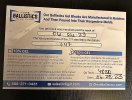Not sure what you are saying. The clear gels meet the same BB penetration tests. Are you saying that data derived from clear gel testing is invalid? How do you know that. Those gels are very stable and a lot of mechanistic behavior of bullets can be gleaned from their use. The whole notion that a gel, organic or otherwise, is an accurate surrogate for live animals is almost laughable. Gels, organic or otherwise, are much more uniform in density and structure than a live animal. Things like failure to expand reliably as a function of tip design and materials as well as hollow point design are readily observable in organic as well as properly calibrated inorganic gels. Bullet expansion or fragmentation, penetration and wound channel size are also readily observed in either gel type. The fact is that expansion and penetration are readily observed in either gel as long as the densities of the gels are the same. In my own experience, the clear gel testing we did with the 150 gr 308BD bullet in gel predicted that it could penetrate up to 30-35" depending on the speed of impact and degree of expansion. When I recovered the bullet that killed a large Coastal Black Bear that had been shot at about a 25 degree angle through the chest traveled 32" through the animal to lodge under the pelt in a fully expanded state. The clear gel testing accurately predicted not only the expansion, but also the penetration depth. Clear gel also predicts that heavier bullets will penetrate deeper than lighter bullets given the same degree of expansion. I don't doubt that organic gels, whose density can vary as a function of temperature, could predict the same behaviors.

